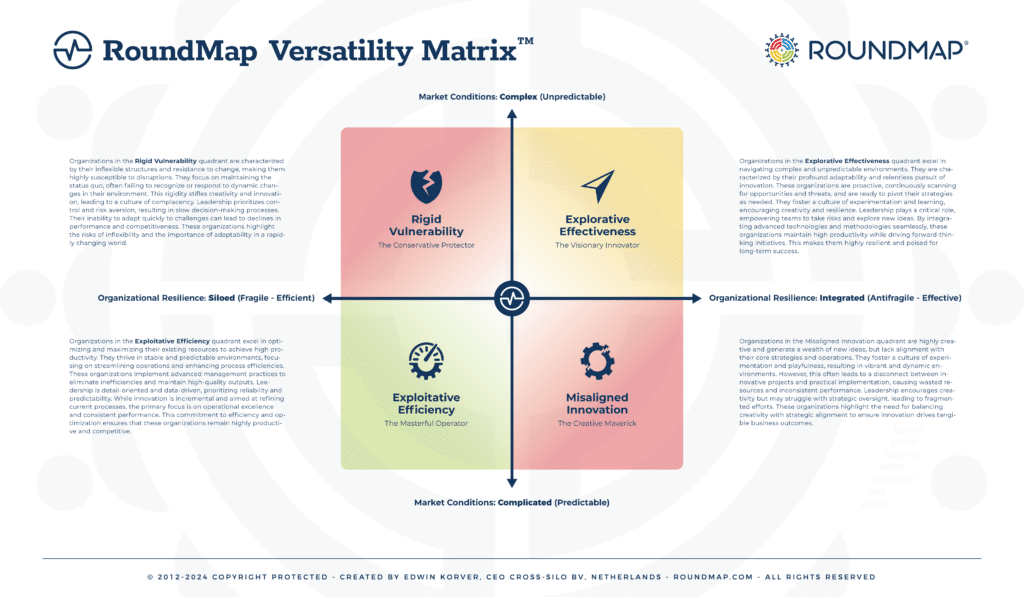The RoundMap Versatility Matrix is a strategic tool designed to help leaders navigate the complexities of modern business environments. It provides a framework for understanding how different organizational approaches can be optimized depending on the prevailing market conditions. The matrix categorizes organizations into four quadrants, each representing a unique combination of adaptability, innovation, efficiency, and vulnerability.
Purpose of the Versatility Matrix
The primary purpose of the RoundMap Versatility Matrix is to guide leaders in aligning their organizational strategies with the external environment. As market conditions evolve, businesses must prioritize exploration and innovation or focus on exploitation and efficiency. The matrix helps leaders identify the most suitable state for their organization, ensuring that their operations are aligned with current realities and future prospects.
The Importance of Integration in Complex and Unpredictable Markets
When market conditions become complex and unpredictable, integration becomes crucial. Organizations must be highly adaptive and innovative in such environments to survive and thrive. The Explorative Effectiveness quadrant represents organizations that excel in these conditions by continuously exploring new opportunities and rapidly adapting to changes. Leaders need to foster a culture of creativity and agility, breaking down silos and promoting cross-functional collaboration to ensure that the organization can pivot and respond to emerging trends and challenges effectively.
When Siloed Operations Are Acceptable
Conversely, maintaining siloed operations can be beneficial in stable and predictable environments. The Exploitative Efficiency quadrant highlights organizations that optimize their resources and processes to achieve high productivity. In these conditions, it is sensible to streamline operations, reduce waste, and improve efficiency. Innovation and agility are less critical, and the emphasis is on maintaining consistent performance and maximizing output.
Balancing Adaptability and Efficiency
The Versatility Matrix underscores that there is no universally best state for an organization. The optimal state depends on the specific conditions of the market. Agility and innovation are essential when navigating volatile and uncertain environments, but these attributes may lead to inefficiencies and misalignment in stable contexts. Conversely, a rigid focus on efficiency can be detrimental in dynamic markets where adaptability is critical.
Avoiding the Pitfalls of Rigidity and Misalignment
The Rigid Vulnerability quadrant describes organizations that fail to adapt to changing conditions. These organizations risk becoming obsolete as they struggle to respond to disruptions. Similarly, the Misaligned Innovation quadrant warns against pursuing innovation without strategic alignment, which can result in wasted resources and inconsistent performance.
Strategic Flexibility
The RoundMap Versatility Matrix encourages leaders to cultivate strategic flexibility, recognizing that the optimal organizational state is dynamic and context-dependent. By understanding the characteristics and implications of each quadrant, leaders can make informed decisions that align their operations with their markets’ current and future needs.
In summary, the RoundMap Versatility Matrix provides a comprehensive framework for aligning organizational strategies with market conditions. It emphasizes that there is no one-size-fits-all approach, and leaders must continuously assess and adjust their strategies to ensure long-term success and resilience.
Personalities of the Four Quadrants
By attributing personalities to each quadrant, leaders can better understand the intrinsic characteristics and behaviors associated with different organizational states. This can aid in identifying current strengths and areas for improvement, ultimately helping organizations align their strategies more effectively with their environments.
- Explorative Effectiveness
- Personality: The Visionary Innovator
- Description: Dynamic, curious, and forward-thinking, the Visionary Innovator thrives on change and always seeks new opportunities. This personality is driven by a desire to explore uncharted territories and is adept at navigating complexity with agility and creativity. They inspire others with their bold ideas and adaptive strategies, continuously pushing the boundaries of what’s possible.
- Exploitative Efficiency
- Personality: The Masterful Operator
- Description: Methodical, disciplined, and efficiency-driven, the Masterful Operator excels in optimizing resources and refining processes. This personality is focused on maintaining stability and maximizing productivity within a well-defined framework. They are reliable and detail-oriented and execute plans precisely, ensuring consistent performance and operational excellence.
- Rigid Vulnerability
- Personality: The Conservative Protector
- Description: Cautious, risk-averse, and tradition-bound, the Conservative Protector prioritizes maintaining the status quo and minimizing disruptions. This personality is focused on control and predictability, often at the expense of adaptability and innovation. They may resist change and respond slowly to external shifts, making them vulnerable in dynamic environments. Their strength lies in their ability to preserve order and consistency, which can also be a significant limitation.
- Misaligned Innovation
- Personality: The Creative Maverick
- Description: Imaginative, spontaneous, and experimental, the Creative Maverick is brimming with new ideas and unconventional solutions. This personality thrives on innovation but often lacks the strategic focus to align these ideas with broader organizational goals. They bring a vibrant and energetic spirit to the table, but their efforts can be scattered and disconnected from practical implementation, leading to inefficiencies and missed opportunities.
THE FOUR QUADRANTS EXPLAINED
Let’s have a closer look at each of the four quadrants of the RoundMap Versatility Matrix:
Explorative Effectiveness
The Explorative Effectiveness quadrant of the Versatility Matrix epitomizes the pinnacle of adaptability and innovation within an organization. Organizations that fall into this quadrant are characterized by their ability to navigate and thrive in complex and unpredictable environments. These organizations are not only open to change but actively seek it, recognizing that continuous exploration and innovation are key to their sustained success.
At the core of Explorative Effectiveness lies a profound adaptability. These organizations are akin to agile navigators, constantly scanning their environments for new opportunities and potential threats. They adopt a proactive approach, always prepared to pivot and adjust their strategies in response to emerging trends and shifts in the market. This adaptability is not just a trait, but a culture that empowers employees to experiment and learn from failures, fostering a resilient and forward-thinking mindset among them.
Innovation is another pillar of this quadrant. Organizations here are relentless in pursuing new ideas and better ways of doing things. They invest heavily in research and development, not just to keep up with competitors but to lead the way in their industries. This innovation is not random or haphazard; it is strategically aligned with the organization’s goals and vision, ensuring that new initiatives drive real value and growth, instilling confidence in the organization’s direction and purpose.
Moreover, these organizations excel in integrating new technologies and methodologies into their operations. They leverage advanced analytics, automation, and other cutting-edge tools to enhance their capabilities and efficiencies. This seamless integration allows them to maintain high levels of productivity even as they adopt new processes and systems.
The leadership within organizations in the Explorative Effectiveness quadrant plays a critical role in their success. Leaders here are visionary and supportive, creating an environment where creativity and bold thinking are encouraged. They empower teams to take risks and explore uncharted territories, knowing this is where the greatest opportunities lie.
In essence, the Explorative Effectiveness quadrant depicts dynamic and future-oriented organizations. They are not content with the status quo and always seek the next big breakthrough. Their ability to adapt quickly, innovate continuously, and integrate new advancements effectively makes them highly resilient and poised for long-term success. These organizations exemplify how embracing change and fostering a culture of exploration can lead to extraordinary effectiveness and impact.
Misaligned Innovation
The Misaligned Innovation quadrant of the Versatility Matrix represents organizations characterized by high levels of creativity and innovation but lacking alignment with their core strategies and operational processes. These organizations are often overly playful, meaning they generate a wealth of new ideas and innovative initiatives but struggle to integrate these innovations effectively into their overall business strategy.
In this quadrant, organizations are driven by a culture of experimentation and creativity. They encourage their teams to think outside the box and pursue unconventional solutions to problems. This results in a vibrant and dynamic environment where new ideas flourish. However, the downside of this playfulness is a lack of focus and coherence in their innovation efforts. The innovative activities may be scattered and not strategically aligned with the organization’s long-term goals.
The operational processes in Misaligned Innovation organizations often fail to keep pace with their creative ambitions. This misalignment can lead to a situation where great ideas do not translate into tangible business outcomes, resulting in wasted resources. The organization invests time and effort into initiatives that do not yield the expected returns, highlighting the crucial need for strategic alignment and practical implementation.
Leadership in these organizations is typically enthusiastic about innovation and fosters an open and exploratory culture. However, there may be a lack of strategic oversight and coordination, causing innovative efforts to become fragmented. Leaders play a crucial role in balancing the need for creativity with the necessity of aligning innovation with the organization’s strategic objectives, underscoring their responsibility to maintain a balanced approach.
The overly playful nature of these organizations can also lead to inconsistencies in performance. While they may achieve breakthrough innovations occasionally, the lack of alignment and focus means that these successes are not reliably repeatable. The organization might experience highs and lows, with periods of intense creativity followed by phases of stagnation due to the inability to implement and sustain new initiatives effectively.
In essence, the Misaligned Innovation quadrant depicts organizations that excel in generating new ideas but struggle with strategic alignment and practical implementation. Their overly playful approach to innovation can lead to a disconnect between creativity and business outcomes, resulting in inefficiencies and inconsistencies. These organizations highlight the importance of fostering creativity and ensuring that innovation efforts are strategically aligned and effectively integrated into the core business operations.
Exploitative Efficiency
The Exploitative Efficiency quadrant of the Versatility Matrix is a testament to the success of organizations that have mastered the art of optimizing and maximizing their existing resources. These organizations, operating in stable and predictable environments, have honed their processes, enhanced efficiency, and consistently delivered outstanding results, setting a benchmark for operational excellence.
In this quadrant, organizations strategically leverage their existing capabilities and assets to their fullest potential. Their focus on streamlining operations, reducing waste, and improving process efficiencies is not just about optimization, but about a thoughtful approach to doing more with less. This strategic thinking often leads to significant cost savings and higher profit margins.
Efficiency is the hallmark of these organizations. They implement well-defined procedures and standards that ensure consistency and reliability in their outputs. Advanced management practices, such as Six Sigma and Lean, are commonly employed to eliminate inefficiencies and enhance productivity. These organizations are masters of operational excellence, with a keen eye on maintaining quality while maximizing throughput.
The environment within Exploitative Efficiency organizations is also a testament to stability and discipline. Performance metrics and key performance indicators (KPIs) are used to monitor progress and identify areas for improvement, providing a clear roadmap for success. Employees are trained to follow best practices and adhere to established protocols, ensuring that everyone is aligned with the organization’s efficiency goals.
Leadership in this quadrant is focused on maintaining stability and optimizing performance. Leaders are often detail-oriented and data-driven, using empirical evidence to guide decision-making. They place a high value on reliability and predictability, ensuring the organization can deliver consistent results to its stakeholders.
While innovation is not the primary focus in this quadrant, it is not absent. Organizations in the Exploitative Efficiency quadrant pursue improvements and incremental innovations that enhance their operations. However, these innovations typically aim to refine and perfect current processes rather than explore entirely new avenues.
In essence, the Exploitative Efficiency quadrant depicts highly productive and efficient organizations. They thrive in stable environments by maximizing their existing resources and capabilities. Their commitment to operational excellence and continuous improvement ensures they consistently deliver high-quality results. These organizations exemplify the power of efficiency and optimization in driving productivity and maintaining competitive advantage.
Rigid Vulnerability
The Rigid Vulnerability quadrant of the Versatility Matrix represents organizations characterized by inflexible structures and processes, which make them highly susceptible to disruptions and changes in their environment. These organizations tend to operate with a fixed mindset, adhering strictly to established routines and resistant to change. This rigidity often stems from a focus on maintaining the status quo and a reluctance to adapt to new circumstances.
Organizations in this quadrant are often described as ‘mostly ignorant’ because they fail to recognize or respond to their external environment’s dynamic changes and complexities. This ignorance, not necessarily due to a lack of intelligence or capability, is a critical issue that needs to be addressed. It’s a result of an insular mindset that prioritizes internal stability over external adaptability. As a result, these organizations may be caught off guard by unexpected events, market shifts, or technological advancements, underlining the urgency of recognizing and responding to external changes.
The structures and processes within Rigid Vulnerability organizations are typically hierarchical and bureaucratic. Decision-making processes are slow and cumbersome, with a strong emphasis on following established protocols. This rigidity can stifle creativity and innovation, as employees may feel constrained by the lack of flexibility and the fear of deviating from the norm.
Leadership in these organizations often focuses on control and risk aversion. Leaders may prioritize maintaining order and predictability over encouraging experimentation and change. This conservative approach can lead to a culture of complacency, a detrimental state where the organization becomes increasingly disconnected from external realities and less capable of responding effectively to challenges. This highlights the urgent need for a shift in leadership approach and organizational culture.
The vulnerability of these organizations lies in their inability to adapt. When faced with disruptions, they may struggle to pivot quickly or implement necessary changes, leading to potential declines in performance and competitiveness. Their rigid structures can become liabilities, hindering their ability to innovate and evolve.
In essence, the Rigid Vulnerability quadrant depicts organizations that are inflexible and slow to adapt, making them highly vulnerable to environmental changes. Their focus on maintaining the status quo and resistance to change can leave them ill-prepared for disruptions, ultimately threatening their long-term viability. These organizations highlight the risks associated with rigidity and the importance of fostering adaptability and responsiveness in a rapidly changing world.
How to Use the Versatility Matrix
To effectively utilize the RoundMap Versatility Matrix, leaders should assess their current market conditions and organizational resilience. Begin by plotting your organization on the matrix, identifying which quadrant most accurately represents your current state. This self-assessment requires a candid evaluation of external factors (market complexity and predictability) and internal factors (degree of integration and resilience).
Once your organization’s position is identified on the RoundMap Versatility Matrix, it’s time to put it to work. Use the characteristics of your quadrant to inform your strategic planning. For example, if you need to transition to the Explorative Effectiveness quadrant, leverage your strengths in adaptability and innovation to continuously seek new opportunities and improve your resilience to market changes. Conversely, if conditions favor the Exploitative Efficiency quadrant, optimize your current processes and maintain high productivity to capitalize on stable market conditions.
If you identify that your current state is not aligned with your market conditions (e.g., being in the Rigid Vulnerability quadrant in a highly dynamic market), the matrix provides a clear direction for transformation. Implement strategies to increase adaptability and integration, such as fostering a culture of innovation, encouraging cross-functional collaboration, and investing in agile processes and technologies.
Additionally, the matrix can help in strategic foresight by preparing for shifts in market conditions. Regularly revisiting your position on the matrix allows you to anticipate changes and proactively adjust your organizational strategies. This ongoing alignment ensures that you remain competitive and resilient, capable of thriving regardless of how external conditions evolve.
Using the RoundMap Versatility Matrix, leaders can make informed decisions that balance efficiency with innovation, adaptability with stability, and, ultimately, guide their organizations towards sustainable success in an ever-changing business landscape.
Conclusion
If the Versatility Matrix teaches us one thing, there is no universal best practice or ideal management style that applies to all circumstances. Business success is highly conditional and dependent on aligning organizational resilience with prevailing market conditions. Organizations that fail to achieve this alignment are destined to struggle and potentially run aground.
While many consultants advocate for a shift towards becoming agile, highly innovative, and integrated, this approach is not a one-size-fits-all solution. It is particularly effective in dynamic and unpredictable environments where adaptability and innovation are crucial for survival. However, this state can only be sustainable temporarily as it demands significant resources and continuous change.
Ultimately, as markets stabilize and become more predictable, the focus should shift toward optimizing existing resources and processes. This transition allows organizations to move into the Exploitative Efficiency quadrant, a space of potential success, where they can capitalize on stability to maximize productivity and efficiency. By doing so, they ensure consistent performance and operational excellence.
The key takeaway from the RoundMap Versatility Matrix is that strategic flexibility and contextual awareness are essential. It’s your role, as business leaders, managers, and consultants, to be adept at assessing your environment and adjusting your organizational strategies accordingly. By understanding and leveraging the characteristics of each quadrant, you can navigate through varying conditions and achieve sustainable success in the long term.
























